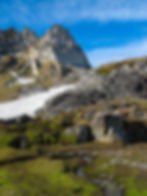

The Fragility of the Arctic Tundra

The Arctic tundra, a vast, frozen wilderness, is one of the most extreme and unique ecosystems on Earth. Characterised by its icy landscape, low temperatures, and short growing seasons, the tundra is home to a surprising array of life, from hardy plants to iconic wildlife like the rock ptarmigan and caribou. However, this delicate ecosystem is under severe threat as the effects of climate change accelerate, making the Arctic tundra a crucial indicator of the planet's rapidly changing climate.

The Arctic tundra is a treeless biome that encircles the northernmost regions of the globe, stretching across parts of Alaska, Canada, Greenland, Iceland, and Russia. Here, temperatures can plunge as low as -40°C (-40°F) during winter, with the land remaining frozen for much of the year. Despite its harsh conditions, the tundra comes alive during the short summer, when the top layer of soil, known as the active layer, thaws, allowing a variety of plants—like mosses, lichens, and small shrubs—to grow. However, climate change is causing dramatic shifts in the tundra’s ecosystem. Warmer temperatures are allowing new plant species to migrate northward, altering the landscape and potentially outcompeting native tundra plants that are well-adapted to colder conditions. This shift in vegetation can have cascading effects on wildlife, particularly species that rely on specific plants for food or shelter.

Beneath the active layer lies permafrost, a thick layer of permanently frozen soil that has been undisturbed for thousands of years. The permafrost plays a critical role in regulating the global climate by trapping vast amounts of carbon dioxide and methane—two powerful greenhouse gases—beneath the frozen surface. One of the most concerning impacts of climate change on the Arctic tundra is the thawing of permafrost. When the permafrost melts, the organic matter trapped within begins to decompose, releasing carbon dioxide and methane into the atmosphere. These gases further contribute to global warming with scientists estimating that the Arctic permafrost contains twice as much carbon as is currently in the atmosphere, making its release a significant climate risk.

While the future of the Arctic tundra is uncertain, there are steps we can take to mitigate the damage and protect this vital ecosystem. This includes reducing greenhouse gas emissions, establishing protected and conservation areas and continuing scientific research and monitoring. The Arctic tundra is at the frontline of climate change, serving as both a warning and a reminder of the far-reaching consequences of a warming planet. Protecting the Arctic tundra is not just about saving an ecosystem; it’s about safeguarding the global climate and the future of our planet.







